Apps
Auto Added by WPeMatico
Auto Added by WPeMatico
Facebook might have another Cambridge Analytica on its hands. In a late Friday news dump, Facebook revealed that today it filed a lawsuit alleging South Korean analytics firm Rankwave abused its developer platform, and has refused to cooperate with a mandatory compliance check regarding how it used Facebook data.

TechCrunch has attained a copy of the lawsuit that alleges that Rankwave misused Facebook data outside of the apps where it was collected, purposefully delayed responding to a cease-and-desist order, claimed it didn’t violate Facebook policy, lied about not using its apps since 2018 when they were accessed in April 2019, and then refused to comply with a mandatory audit of its data practices.
“By filing the lawsuit, we are sending a message to developers that Facebook is serious about enforcing our policies, including requiring developers to cooperate with us during an investigation” Facebook’s director of platform enforcement and litigation Jessica Romero wrote. Facebook tells TechCrunch that “To date Rankwave has not participated in our investigation and we are trying to get more info from them to determine if there was any misuse of Pages data.”

Facebook explains that “Rankwave used the Facebook data associated with Rankwave’s apps to create and sell advertising and marketing analytics and models — which violated Facebook’s policies and terms” and that it “failed to comply with Facebook’s requests for proof of Rankwave’s compliance with Facebook policies, including an audit.”
More specifically, Facebook cites that its “Platform Policies largely restrict Developers from using Facebook data outside of the environment of the app, for any purpose other than enhancing the app users’ experience on the app.” But Rankwave used Facebook data outside those apps.
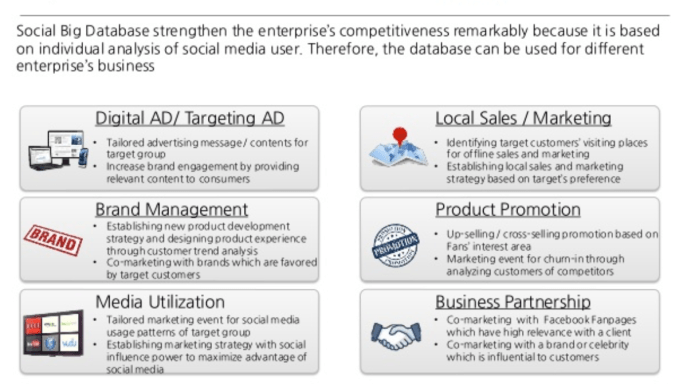
Facebook alleges that “Rankwave’s B2B apps were installed and used by businesses to track and analyze activity on their Facebook Pages . . . Rankwave operated a consumer app called the “Rankwave App.” This consumer app was designed to measure the app user’s popularity on Facebook by analyzing the level of interaction that other users had with the app user’s Facebook posts. On its website, Rankwave claimed that this app calculated a user’s ‘Social influence score’ by ‘evaluating your social activities’ and receiving ‘responses from your friends.’”
Facebook is seeking monetary damages plus injunctive relief restraining Rankwave from accessing the Facebook Platform, requiring it to comply with Facebook’s audit, requiring that it delete all Facebook data.
You can learn more about Rankwave’s analytics practices from this 2014 presentation.
Powered by WPeMatico
Uber finally made its debut Friday on the New York Stock Exchange, ending its decade-long journey from startup to publicly traded company.
So far, it’s been a ho-hum beginning, with shares opening at $42, down from the IPO price. The share price is hovering just under $44.
Thirteen people, including executives, early employees, drivers and customers, were on the balcony for the historic bell ringing that opened the markets Friday. Noticeable absentees were co-founder Garrett Camp and former CEO and co-founder Travis Kalanick, who was ousted from the company in June 2017 after a string of scandals around Uber’s business practices.
Kalanick, who still sits on the board and has an 8.6% stake in Uber, wasn’t part of the opening bell ceremony. However, Kalanick and Camp were both at the NYSE for the event.
Here is who participated in the opening bell ceremony.
Austin Geidt, who rang the bell, was employee No. 4 when she started as an intern in 2010, and is one of Uber’s earliest employees.
Geidt joined Uber in 2010 and has since worked in numerous positions at the company. She led Uber’s expansion in hundreds of new cities and dozens of new countries. Geidt now heads up strategy for Uber’s Advanced Technologies Group, the unit working on autonomous vehicles.
CEO Dara Khosrowshahi stood next to Geidt at the opening of the market Friday. Khosrowshahi joined Uber in 2017 after Kalanick resigned and the board launched an extensive search for an executive who could change the culture at the company and prepare it for an eventual IPO.
Khosrowshahi was the CEO of Expedia before joining Uber. Khosrowshahi gave a one-year update on his time at Uber during TechCrunch Disrupt in September 2018.
Uber CTO Thuan Pham has been with the company since 2013. Prior to coming to Uber, Pham was vice president of engineering at VMware.
Rachel Holt, vice president and head of New Mobility, was also on hand. Holt has worked at Uber since October 2011, when the company was live in just three cities. In May 2016, she became VP and regional general manager of Uber’s operations in the U.S. and Canada.
She was promoted to head up new mobility in June 2018. She’s responsible for the ramp-up and onboarding of additional mobility services, including public transit integration, scooters, car rentals and bikes.
Other executives included Pierre-Dimitry Gore-Coty and Andrew MacDonald, both vice presidents and regional general managers at Uber, as well as Jason Droege, a vice president who heads up Uber Eats.
Droege, who joined Uber in 2014, has the official title of head of UberEverything. This is the team that created the food delivery service Uber Eats, which now operates in 35 countries.
Uber had five drivers on hand for the opening bell, who represented different services and geographies.
Among the drivers were:
One customer, Elise Wu, also participated in the opening bell. Wu owns Kampai, a family of restaurants in France that serves affordable cuisine made available for delivery through Uber Eats.
Powered by WPeMatico
Such hate. Such dismay. “How Slack is ruining work.” “Actually, Slack really sucks.” “Slack may actually be hurting your workplace productivity.” “Slack is awful.” Slack “destroys teams’ ability to think, plan & get complex work out the door.” “Slack is a terrible collaboration tool.” “Face it, Slack is ruining your life.”
Contrarian view: Slack is not inherently bad. Rather, the particular way in which you are misusing it epitomizes your company’s deeper problems. I’m the CTO of a company which uses Slack extensively, successfully, and happily — but because we’re a consultancy, I have also been the sometime member of dozens of others’ Slack workspaces, where I have witnessed all the various flavors of flaws recounted above. In my experience, those are not actually caused by Slack.
Please note that I am not saying “Slack is just a tool, you have to use it correctly.” Even if that were so, a tool which lends itself so easily to being used so badly would be a bad tool. What I’m saying is something more subtle, and far more damning: that Slack is a mirror which reflects the pathologies inherent in your workplace. The fault, dear Brutus, is not in our Slacks, but in ourselves.
Powered by WPeMatico
Instagram isn’t just pretty pictures. It now also harbors bullying, misinformation and controversial self-expression content. So today Instagram is announcing a bevvy of safety updates to protect users and give them more of a voice. Most significantly, Instagram will now let users appeal the company’s decision to take down one of their posts.
A new in-app interface (rolling out starting today) over the next few months will let users “get a second opinion on the post,” says Instagram’s head of policy, Karina Newton. A different Facebook moderator will review the post, and restore its visibility if it was wrongly removed, and they’ll inform users of their conclusion either way. Instagram always let users appeal account suspensions, but now someone can appeal a takedown if their post was mistakenly removed for nudity when they weren’t nude or hate speech that was actually friendly joshing.
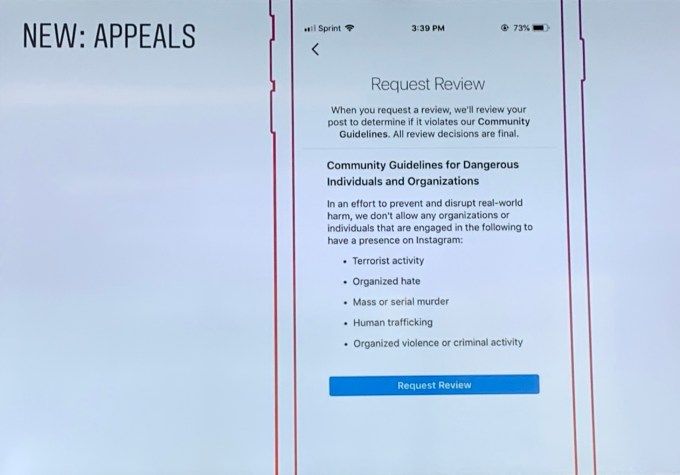
On the misinformation front, Instagram will begin blocking vaccine-related hashtag pages when content surfaced on a hashtag page features a large proportion of verifiably false content about vaccines. If there is some violating content, but under that threshold, Instagram will lock a hashtag into a “Top-only” post, where Recent posts won’t show up, to decrease visibility of problematic content. Instagram says that it will test this approach and expand it to other problematic content genres if it works. Instagram will also be surfacing educational information via a pop-up to people who search for vaccine content, similar to what it’s used in the past for self-harm and opioid content.
Instagram says now that health agencies like the Center for Disease Control and World Health Organization are confirming that VACCINES DO NOT CAUSE AUTISM, it’s comfortable declaring contradictory information as verifiably false, and it can be aggressively demoted on the platform.
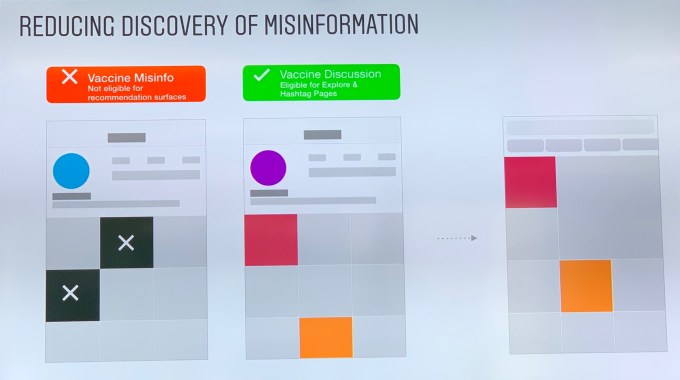
The automated system scans and scores every post uploaded to Instagram, checking them against classifiers of prohibited content and what it calls “text-matching banks.” These collections of fingerprinted content it’s already banned have their text indexed and words pulled out of imagery through optical character recognition so Instagram can find posts with the same words later. It’s working on extending this technology to videos, and all the systems are being trained to spot obvious issues like threats, unwanted contact and insults, but also those causing intentional fear-of-missing-out, taunting, shaming and betrayals.
If the AI is confident a post violates policies, it’s taken down and counted as a strike against any hashtag included. If a hashtag has too high of a percentage of violating content, the hashtag will be blocked. If it had fewer strikes, it’d get locked in Top-Only mode. The change comes after stern criticism from CNN and others about how hashtag pages like #VaccinesKill still featured tons of dangerous misinformation as recently as yesterday.
One other new change announced this week is that Instagram will no longer determine whether to suspend an account based on the percentage of their content that violates policies, but by a tally of total violations within a certain period of time. Otherwise, Newton says, “It would disproportionately benefit those that have a large amount of posts,” because even a large number of violations would be a smaller percentage than a rare violation by someone who doesn’t post often. To prevent bad actors from gaming the system, Instagram won’t disclose the exact time frame or number of violations that trigger suspensions.
Instagram recently announced at F8 several new tests on the safety front, including a “nudge” not to post a potentially hateful comment a user has typed, “away mode” for taking a break from Instagram without deleting your account and a way to “manage interactions” so you can ban people from taking certain actions like commenting on your content or DMing you without blocking them entirely.
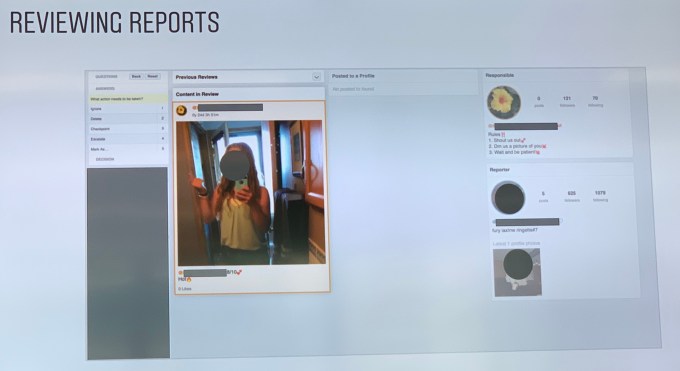
The announcements come as Instagram has solidified its central place in youth culture. That means it has intense responsibility to protect its user base from bullying, hate speech, graphic content, drugs, misinformation and extremism. “We work really closely with subject matter experts, raise issues that might be playing out differently on Instagram than Facebook, and we identify gaps where we need to change how our policies are operationalized or our policies are changed,” says Newton.
Powered by WPeMatico
There’s a new teen app sensation. Anonymous question-asking app YOLO has rocketed to the #1 US app position just a week after launching thanks to Snapchat. Built on top of the Snap Kit platform, YOLO uses Snapchat for login and Bitmoji profile pics to let you add an “ask me anything” sticker to your Snapchat Story. Friends can swipe up to open YOLO on iOS and send an anonymous question there that you then answer through another sticker posted to your Story. One source says “EVERYONE at my high school is using it right now.” And what’s crazy is that YOLO’s inventor tells me the whole thing was an accident.
If you’re getting deja vu, you might be thinking of Sarahah. That app blew up in late 2017 by letting you attach a link from your Snapchat Story to your Sarahah profile where people could ask you anonymous questions…until it was kicked off of iOS and Android in early 2018 for facilitating bullying. Or maybe you’re thinking of how polling app Polly let Snapchat friends ask you anything before there was Snap Kit.
Now the question is whether YOLO’s warning during signup that it has “no tolerance for objectionable content or abusive users” or its in-app flagging and blocking features will protect it from teen misuse or Apple and Google’s wrath.

YOLO’s anonymous question app built on Snap Kit is now the #1 US app
YOLO’s rise highlights just how curious teens are and how desperate they can be for honest feedback or anonymous gossip. Given the prompt via Snapchat to say something to friends without having to take responsibility, kids are flocking to download YOLO. Since they don’t have to create a new profile or pic thanks to Snap Kit importing their account and Bitmoji, and can use Snapchat’s ubiquity amongst teens to distribute their question and answers, YOLO is super easy to join. That pushed it to the #1 US app according to App Annie.

YOLO creator Gregoire Henrion
But as with Sarahah, Secret, YikYak, and other anonymous apps before it, YOLO is vulnerable to being used to spread hate speech and bullying. Given school-age kids can get in trouble for insulting someone in the hallway, they’re quick to torment peers though apps, especially if they piggyback on one everyone already uses.
Now Yolo’s developer, a startup called Popshow, is desperately trying to keep the app’s servers from melting and add new features so teens stick around. There was no publicly available info about who started Popshow, even in its trademark and incorporation filings. But after some digging, a source revealed that Popshow and YOLO were started by Gregoire Henrion, former co-founder and CEO of music video making app Mindie.
“It was not supposed to be a success. It was just for us to learn” Henrion tells me in his first interview about his startup. “Let’s just put it on the App Store and see how people behave. It went 100% viral. It’s crazy. Even we didn’t believe our eyes when we saw that [it went to #1].”
Henrion’s previous startup Mindie had let you share soundtracked video clips to your Snapchat story. It raised $1.2 million from Lowercase, SV Angel, Dave Morin, Troy Carter and more. But in 2015 it got blocked from Snapchat for being a security risk since it required users to provide their Snap username and password. YOLO actually takes advantage of Snapchat’s Snap Kit platform that was designed specifically to eliminate the need for Mindie’s sketchy integrations. Mindie missed its opportunity to become Musical.ly, which was later bought and merged into global phenomenon TikTok. Mindie eventually got acquired by Justin Bieber-backed selfie app and content production collective Shots in 2016.
By 2017, Henrion and Mindie co-founder Clément Raffenoux were back building a new startup. They raised a small pre-seed round from SV Angel, Shrug Captial, Product Hunt’s Ryan Hoover, and some angel investors and experimented with the Popshow video reactions app. Then the pair decided to explore the anonymous app space. But rather than being completely anonymous and public, YOLO lets users privately review questions, decide which they want to answer and who to share that content with via Snapchat, and include a selfie when they share so respondents know there’s a real person on the other side. “We feel that anonymity can unlock super good behaviors. We think we’re more empathic, more human than other anonymous apps before us” Henrion explains.
The result was “1000X what we expected” Henrion beams. And he insists the growth is totally organic. “We tried some shitty things just to try them, but they don’t work” including replying from Popshow’s account to thousands of people who tweeted ‘I miss Vine’. “I don’t believe in fake growth anymore. We just literally put it in the store, people typed YOLO into search, and the loop was so effective that the product caught on.”
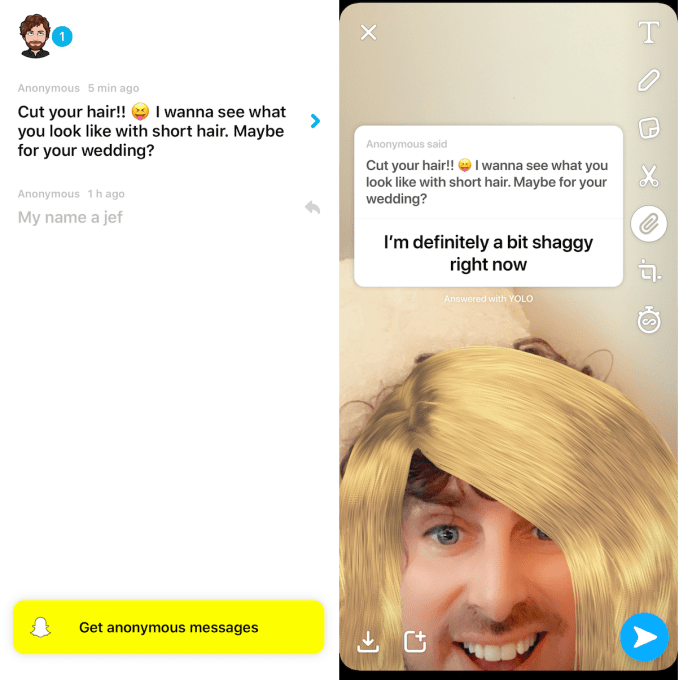
YOLO lets you ask for anonymous questions via your Snapchat Story, receive them on YOLO, and then post the answers back to Snapchat
The challenge will be maintaining YOLO’s momentum. Another anonymous Q&A app called TBH raced to the #1 app spot in September 2017, got acquired by Facebook 3 weeks later, but fell out of the top 500 apps by the end of November before being shut down last year. Teens are extremely fickle. If they deem YOLO “over”, get bored due to a lack of new features, are overwhelemed by harassment, or a new fad arises, it could crash out of the charts. Henrion says his team is scrambling to evolve YOLO into something more expansive without losing simplicity, while developing automated tools to weed out bullies.
There’s also the threat of Snapchat just building similar anonymous Q&A functionality into its own app. But that’s the risk of building atop any platform that otherwise massively reduces an app’s development and marketing costs. This will become a powerful case study that will surely draw tons of developers to Snapchat’s platform. With so much of YOLO powered by Snap Kit, and it all just being an experiment, Henrion won’t lose much if his app dies and he moves on to the next idea.
Powered by WPeMatico
Two years ago, Apple changed the way its app store ratings worked by allowing developers to decide whether or not their ratings would be reset with their latest app update — a feature that Apple suggests should be used sparingly. Today, Google announced it’s making a change to how its Play Store app ratings work, too. But instead of giving developers the choice of when ratings will reset, it will begin to weight app ratings to favor those from more recent releases.
“You told us you wanted a rating based on what your app is today, not what it was years ago, and we agree,” said Milena Nikolic, an engineering director leading Google Play Console, who detailed the changes at the Google I/O Developer conference today.
She explained that, soon, the average rating calculation for apps will be updated for all Android apps on Google Play. Instead of a lifetime cumulative value, the app’s average rating will be recalculated to “give more weight” to the most recent users’ ratings.
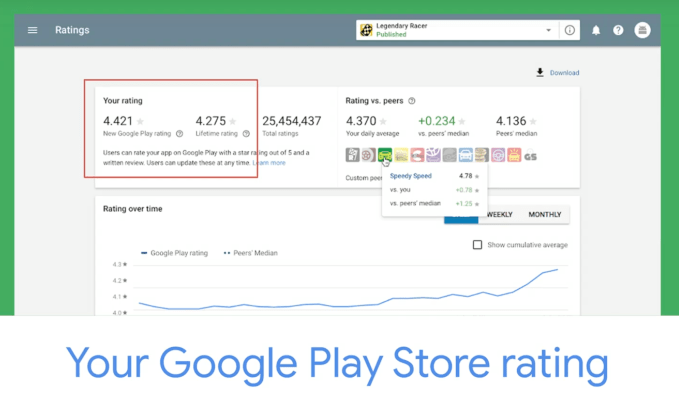
With this update, users will be able to better see, at a glance, the current state of the app — meaning, any fixes and changes that made it a better experience over the years will now be taken into account when determining the rating.
“It will better reflect all your hard work and improvements,” touted Nikolic, of the updated ratings.
On the flip side, however, this change also means that once high-quality apps that have since failed to release new updates and bug fixes will now have a rating that reflects their current state of decline.
It’s unclear how much the change will more broadly impact Google Play Store SEO, where today app search results are returned based on a combination of factors, including app names, descriptions, keywords, downloads, reviews and ratings, among other factors.
The updated app ratings was one of numerous Google Play changes announced today, along with the public launch of dynamic delivery features, new APIs, refreshed Google Play Console data, custom listings and even “suggested replies” — like those found in Gmail, but for responding to Play Store user reviews.
End users of the Google Play Store won’t see the new, recalculated rating until August, but developers can preview their new rating today in their Play Store Console.
Powered by WPeMatico
China’s new rules on video games, introduced last month, are having an effect on the country’s gamers. Today, Tencent replaced hugely popular battle royale shooter game PUBG with a more government-friendly alternative that seems primed to pull in significant revenue.
The company introduced “Game for Peace” in a Weibo post at the same time as PUBG — which stands for Player Unknown Battlegrounds — was delisted from China. The title had been in wide testing but without revenue, and now it seems Tencent gave up on securing a license to monetize the title.
In its place, Game for Peace is very much the type of game that will pass the demands of China’s game censorship body. Last month, the country’s State Administration of Press and Publication released a series of demands for new titles, including bans on corpses and blood, references of imperial history and gambling. The new Tencent title bears a striking resemblance to PUBG, but there are no dead bodies, while it plays up to a nationalist theme with a focus on China’s air force — or, per the Weibo message, “the blue sky warriors that guard our country’s airspace” — and their battle against terrorists.
Game for Peace was developed by Krafton, the Korea-based publisher formerly known as BlueHole which made PUBG. Beyond visual similarities, Reuters reported that the games are twinned since some player found that their progress and achievements on PUBG had transferred over to the new game.
Tencent representatives declined to comment on the new game or the end of PUBG’s “beta testing” period in China when contacted by TechCrunch. But a company rep apparently told Reuters that “they are very different genres of games.”

Tencent’s new “Game for Peace” title is almost exactly the same as its popular PUBG game, which it is replacing [Image via Weibo]
Fortnite may have grabbed the attention for its explosive growth — we previously reported that the game helped publisher Epic Games bank a profit of $3 billion last year — but PUBG has more quietly become a fixture among mobile gamers, particularly in Asia.
At the end of last year, Krafton told The Verge that it was past 200 million registered gamers, with 30 million players each day. According to app analytics company Sensor Tower, PUBG grossed more than $65 million from mobile players in March thanks to 83 percent growth, which saw it even beat Fortnite. There is also a desktop version.
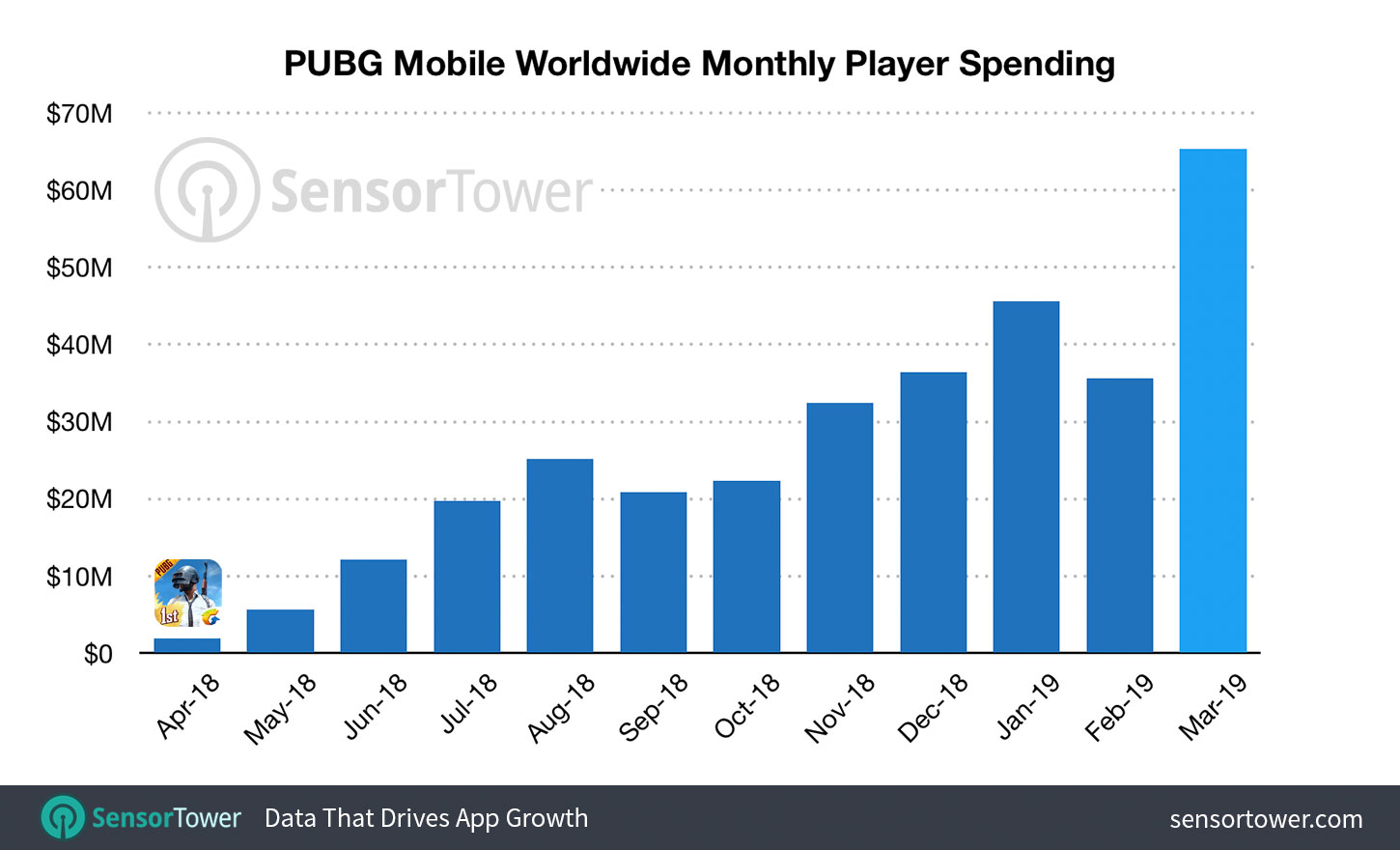
PUBG made more money than Fortnite on mobile in March 2019, according to data from Sensor Tower
That is really the point of Tencent’s switcheroo: to make money.
The company suffered at the hands of China’s gaming license freeze last year, and a regulatory-compliant title like Game for Peace has a good shot at getting the green light for monetization — through the sale of virtual items and seasonal memberships.
Indeed, analysts at China Renaissance believe the new title could rake in as much as $1.5 billion in annual revenue, according to the Reuters report. That’s a lot to get excited about and resuscitating gaming will be an important part of Tencent’s strategy this year — which has already seen it restructure its business to focus emerging units like cloud computing, and pledge to use its technology to “do good.”
Powered by WPeMatico
Mark Zuckerberg: “The future is private”. Sundar Pichai: ~The present is private~. While both CEO’s made protecting user data a central theme of their conference keynotes this month, Facebook’s product updates were mostly vague vaporware while Google’s were either ready to ship or ready to demo. The contrast highlights the divergence in strategy between the two tech giants.
For Facebook, privacy is a talking point meant to boost confidence in sharing, deter regulators, and repair its battered image. For Google, privacy is functional, going hand-in-hand with on-device data processing to make features faster and more widely accessible.
Everyone wants tech to be more private, but we must discern between promises and delivery. Like “mobile”, “on-demand”, “AI”, and “blockchain” before it, “privacy” can’t be taken at face value. We deserve improvements to the core of how our software and hardware work, not cosmetic add-ons and instantiations no one is asking for.
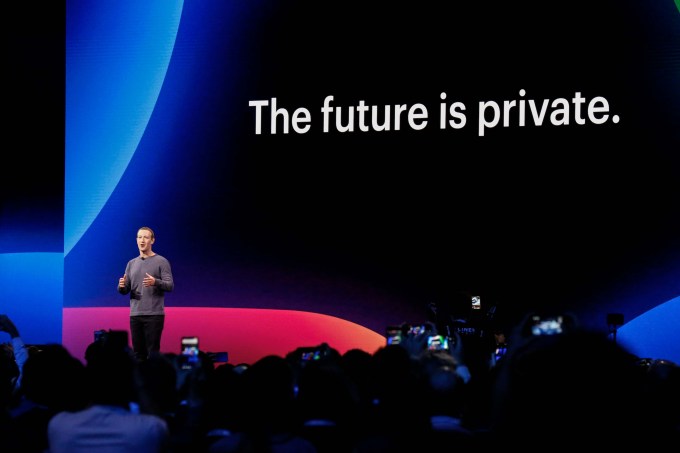
AMY OSBORNE/AFP/Getty Images
At Facebook’s F8 last week, we heard from Zuckerberg about how “Privacy gives us the freedom to be ourselves” and he reiterated how that would happen through ephemerality and secure data storage. He said Messenger and Instagram Direct will become encrypted…eventually…which Zuckerberg had already announced in January and detailed in March. We didn’t get the Clear History feature that Zuckerberg made the privacy centerpiece of his 2018 conference, or anything about the Data Transfer Project that’s been silent for the 10 months since it’s reveal.
What users did get was a clumsy joke from Zuckerberg about how “I get that a lot of people aren’t sure that we’re serious about this. I know that we don’t exactly have the strongest reputation on privacy right now to put it lightly. But I’m committed to doing this well.” No one laughed. At least he admitted that “It’s not going to happen overnight.”
But it shouldn’t have to. Facebook made its first massive privacy mistake in 2007 with Beacon, which quietly relayed your off-site ecommerce and web activity to your friends. It’s had 12 years, a deal with the FTC promising to improve, countless screwups and apologies, the democracy-shaking Cambridge Analytica scandal, and hours of being grilled by congress to get serious about the problem. That makes it clear that if “the future is private”, then the past wasn’t. Facebook is too late here to receive the benefit of the doubt.
At Google’s I/O, we saw demos from Pichai showing how “our work on privacy and security is never done. And we want to do more to stay ahead of constantly evolving user expectations.” Instead of waiting to fall so far behind that users demand more privacy, Google has been steadily working on it for the past decade since it introduced Chrome incognito mode. It’s changed directions away from using Gmail content to target ads and allowing any developer to request access to your email, though there are plenty of sins to atone for. Now when the company is hit with scandals, it’s typically over its frightening efficiency as with its cancelled Project Maven AI military tech, not its creepiness.
Google made more progress on privacy in low-key updates in the runup to I/O than Facebook did on stage. In the past month it launched the ability to use your Android device as a physical security key, and a new auto-delete feature rolling out in the coming weeks that erases your web and app activity after 3 or 18 months. Then in its keynote today, it published “privacy commitments” for Made By Google products like Nest detailing exactly how they use your data and your control over that. For example, the new Nest Home Max does all its Face Match processing on device so facial recognition data isn’t sent to Google. Failing to note there’s a microphone in its Nest security alarm did cause an uproar in February, but the company has already course-corrected

That concept of on-device processing is a hallmark of the new Android 10 Q operating system. Opening in beta to developers today, it comes with almost 50 new security and privacy features like TLS 1.3 support and Mac address randomization. Google Assistant will now be better protected, Pichai told a cheering crowd. “Further advances in deep learning have allowed us to combine and shrink the 100 gigabyte models down to half a gigabyte — small enough to bring it onto mobile devices.” This makes Assistant not only more private, but fast enough that it’s quicker to navigate your phone by voice than touch. Here, privacy and utility intertwine.
The result is that Google can listen to video chats and caption them for you in real-time, transcribe in-person conversations, or relay aloud your typed responses to a phone call without transmitting audio data to the cloud. That could be a huge help if you’re hearing or vision impaired, or just have your hands full. A lot of the new Assistant features coming to Google Pixel phones this year will even work in Airplane mode. Pichai says that “Gboard is already using federated learning to improve next word prediction, as well as emoji prediction across 10s of millions of devices” by using on-phone processing so only improvements to Google’s AI are sent to the company, not what you typed.

Google’s senior director of Android Stephanie Cuthbertson hammered the idea home, noting that “On device machine learning powers everything from these incredible breakthroughs like Live Captions to helpful everyday features like Smart Reply. And it does this with no user input ever leaving the phone, all of which protects user privacy.” Apple pioneered much of the on-device processing, and many Google features still rely on cloud computing, but it’s swiftly progressing.
When Google does make privacy announcements about things that aren’t about to ship, they’re significant and will be worth the wait. Chrome will implement anti-fingerprinting tech and change cookies to be more private so only the site that created them can use them. And Incognito Mode will soon come to the Google Maps and Search apps.

Pichai didn’t have to rely on grand proclamations, cringey jokes, or imaginary product changes to get his message across. Privacy isn’t just a means to an end for Google. It’s not a PR strategy. And it’s not some theoretical part of tomorrow like it is for Zuckerberg and Facebook. It’s now a natural part of building user-first technology…after 20 years of more cavalier attitudes towards data. That new approach is why the company dedicated to organizing the world’s information has been getting so little backlash lately.
With privacy, it’s all about show, don’t tell.
Powered by WPeMatico
Last year at Google I/O, Google introduced a host of new digital well-being tools aimed at helping people better manage their screen time, track app usage and configure their device’s “do not disturb” settings. Today, Google is updating its suite of tools to include a new feature called “Focus Mode” that lets you temporarily disable distracting apps while not missing critical information, as well as a few new features for users of its parental control software, Family Link, which is now part of the Android OS.
With Focus Mode, a new feature for Android devices, you can turn off the apps you personally find distracting while you’re trying to sit down and get things done. For example, you could disable updates from distracting social media apps or email, but could choose to leave texting on so family members could reach you in an emergency.
Though not mentioned during the announcement, the feature also could help people enjoy their devices in their downtime — like streaming from Netflix without getting bothered by Slack notifications and work email. That’s not necessarily a way to reduce screen time — which is what a lot of today’s digital well-being features provide. Instead, it’s about finding balance between when it’s time to work and when it’s not, and what things deserve our attention at a given time.
Also unveiled today at Google I/O were new features for Family Link, Google’s software that lets parents control what kids can do on their devices, and track their usage.
Now, parents can set time limits on specific apps instead of just “screen time” in general. This is similar in a way to what Amazon’s FreeTime parental controls offer, as they allow parents to require that kids finish their reading before they can play games, for example. In Google’s case, it’s instead allowing parents to limit certain apps they believe are distractions to children.
Another new feature will allow parents to give kids extra screen time, or “bonus time.”
This could help kids who need just a few more minutes to wrap up what they’re doing on their device, or could be doled out as a reward, depending on how parents wanted to use the feature.
The company also announced it’s making Family Link part of every Android device, beginning with Android Q. That means Family Link will become accessible from device settings, instead of being an optional app parents can choose to download. You’ll find it under the “digital well-being and parental controls” in Android Q devices rolling out later this summer, says Google.
“We’re spending a lot of time on phones, and people tell us, sometimes they wish they spent more time on other things. We want to help people find balance and digital well-being. And yes, sometimes this means making it easier to put your device away entirely, and focus on the times that really matter,” said Stephanie Cuthbertson, senior director for Android.
She said these tools were already proving useful, as 90% of app timers helped users stick to their goals and there was a 27% drop in nightly usage thanks to Wind Down. However, the company didn’t share how many users were taking advantage of the digital well-being features as a whole.
Powered by WPeMatico
Sitting silently with your eyes closed isn’t fun, but it’s good for you… so you probably don’t meditate as often as you’d like. In that sense, it’s quite similar to exercise. But people do show up when prodded by the urgency and peer pressure of scheduled group cycling or aerobics classes. What’s still in the way is actually hauling your lazy butt to the gym, hence the rise of Peloton’s in-home stationary bike with attached screen streaming live and on-demand classes. My butt is particularly lazy, but I’ve done 80 Peloton rides in four months. The model works.
Now that model is coming to mindfulness with the launch of Journey LIVE, a subscription iOS app offering live 15-minute group meditation classes. With sessions starting most waking hours, instructors that interact with you directly and a sense of herd mentality, you feel compelled to dedicate the time to clearing your thoughts. By video and voice, the teachers introduce different meditation theories and practices, guide you through and answer questions you can type in. Each day, Journey also provides a newly recorded on-demand session in case you need a class on your own schedule.
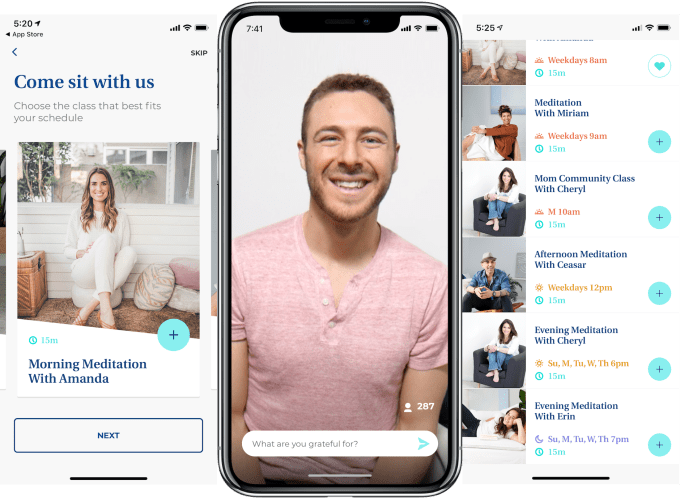
” ‘I tried Headspace’ or ‘I tried Calm .’ With a lot of the current meditation apps, people go on but they drop off very quickly,” says Journey founder and CEO Stephen Sokoler. “It means that there’s an interest in meditating and having a better life but people fall off because meditating alone is hard, it’s confusing, it’s boring. Meditating with a live teacher who can connect with you and say your name, who makes you feel seen and heard makes a huge difference.”
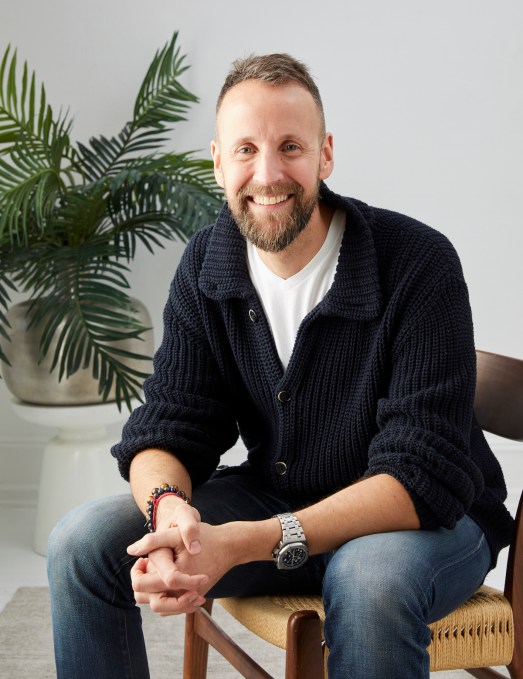 Journey subscriptions start at $19.99 per month after a week-long free trial. That feels a bit steep, but prices drop to $7.99 if paid annually with the launch discount, or you can dive in with a $399 lifetime pass. The challenge will be keeping users from abandoning meditation and then their subscription without resorting to growth hacking and annoying notifications that are antithetical to the whole concept. Journey has now raised a $2.4 million seed round led by Canaan and joined by Brooklyn Bridge Ventures, Betaworks and more to get the company rolling.
Journey subscriptions start at $19.99 per month after a week-long free trial. That feels a bit steep, but prices drop to $7.99 if paid annually with the launch discount, or you can dive in with a $399 lifetime pass. The challenge will be keeping users from abandoning meditation and then their subscription without resorting to growth hacking and annoying notifications that are antithetical to the whole concept. Journey has now raised a $2.4 million seed round led by Canaan and joined by Brooklyn Bridge Ventures, Betaworks and more to get the company rolling.
Sokoler’s own journey could set an example of the possibilities of sticking with it. “Meditation changed my life. I was fortunate enough to move to Australia, find a book on Buddhism, and then I had the willpower to start practicing meditation every day,” he tells me. “I lost 85 pounds. People ask me how I lost the weight and they expect me to say a diet like keto or Atkins, but it was because of the program I was in.” Suddenly able to sit quietly with himself, Sokoler didn’t need food to stay occupied or feel at ease.
The founder saw the need for new sources of happiness while working in employee rewards and recognition for 12 years. He built up a company that makes mementos for commemorating big business deals. Meditation proved to him the value of developing inner quiet, whether to inspire happiness, calm, focus or deeper connections to other people and the world. Yet the popular meditation apps ignored thousands of years of tradition when meditation would be taught in groups that give a naturally ethereal activity more structure. He founded Journey in 2015 to bring meditation to corporate environments, but now is hoping to democratize access with the launch of Journey LIVE.
“You could think of it as a real-life meditation community or studio in the palm of your hand,” Sokoler explains. Instructors greet you when you join a session in the Journey app and can give you a shout-out for practicing multiple days in a row. They help you concentrate on your breath while giving enough instruction to keep you from falling asleep. You can see or hide a list of screen names of other participants that make you feel less isolated and encourage you not to quit.
Finding a market amidst the popular on-demand meditation apps will be an uphill climb for Journey LIVE. While classes recorded a long time ago might not be as engaging, they’re convenient and can dig deep into certain styles and intentions. Calm and Headspace run around $12.99 per month, making them cheaper than Journey LIVE and potentially easier to scale.
But Sokoler says his app’s beta testing saw better retention than competitors. “If you’ve ever been to the New York Public Library, there’s so many books versus going to a local curated bookstore where something is right there for you. This is much more approachable, much more accessible,” Sokoler tells me. “There’s a paradox of choice, and having so many options makes it hard for people to stick with it and come back every single day.”
With our phones and Netflix erasing the downtime we used to rely on to give our brain a break or reflect on our day, life is starting to feel claustrophobic. We’re tense, anxious and easily overwhelmed. Meditation could be the antidote. Unlike with cycling or weightlifting, you don’t need some expensive Peloton bike or Tonal home gym. What you need is consistency, and an impetus to slow down for 15 minutes you could easily squander. We’re a tribal species, and Journey LIVE group classes could use camaraderie to lure us into the satisfying void of nirvana.
Powered by WPeMatico